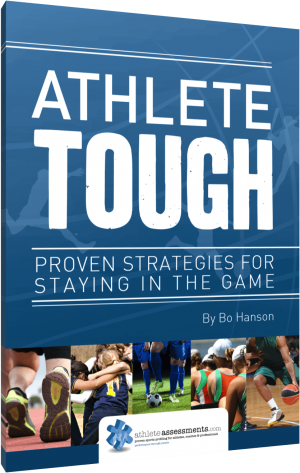Unsafe vs Uncomfortable: 5 Minutes with Bo Hanson
Stepping out of your comfort zone is an important component to growth, personal development and achieving success. As Coaches, we continually encourage our athletes to get comfortable with the uncomfortable in order to expand skill development and improve results. However, there is a big difference between creating experiences and/or environments that are uncomfortable and those that are unsafe. In this ‘5 Minutes with Bo Hanson’, we discuss the important differences between being unsafe and being uncomfortable.
A key concept in ATHLETE TOUGH is that tough athletes enjoy exposing themselves to uncomfortable and challenging environments. It’s part of what makes them tough athletes in the first place.
As an Olympic athlete, I know first-hand that stepping out of our comfort zones is pivotal in achieving success. And while we certainly encourage athletes to do this, to push their limits, it has been brought to my attention that some Coaches confuse being uncomfortable with being unsafe. They are two very separate concepts.
For example, when I was rowing, our Coach would ask us to be up and in the water ready to train by 5am. Some days it was cold and wet and I really didn’t feel like getting up. It was an uncomfortable scenario. But it wasn’t unsafe.
During training, we would have to row an hour in one direction before we could stop for a drink break. Again, this was uncomfortable because it pushed us mentally and physically, but it wasn’t unsafe. We checked hydration before and after our practices.
A professional court based sports team I started working with, had their players train without a physiotherapist (trainer) present at practice. The nearest hospital was a fair distance away and the wait time would be at least two hours if an injury occurred. This is an example of an unsafe scenario. This was a sport where injury was highly likely and players weren’t training to their full potential for fear of getting hurt. We worked with the team, got a physio and a massage therapist on board at practice and the players were instantly willing to train harder. They were challenged during their practice sessions and pushed hard by their Coach, but the environment was no longer unsafe.
We need to remember that we develop toughness when we get out of our comfort zone, but we should never push ourselves to the point where we break. We should never get to a place that is unsafe. And as Coaches, we need to know the difference and encourage our athletes to test themselves while still maintaining a safe environment for themselves and their team members.
Watch the above video for the full discussion on the differences between coaching your athletes on pushing through to being uncomfortable, without tipping into being unsafe.

Take a Holistic Approach
It is important to remember – as Coaches we are responsible for an athlete’s whole development. Gone are the times when all a Coach had to do was teach an athlete how to catch or pass a football, run or swim. The defining factor in an athlete’s performance is not going to come down to their technical skills but rather their non-technical skills and of those being resilient is a foundation skill. When I write articles like this, it reminds me to improve my skills in this area. I firmly believe all of us can continue to develop and provide a learning experience for those around us. As a consequence we will provide a role model example of how to behave.
Where to from here…
If you enjoyed this topic, you may also value these articles:
- 9 Things Tough Athletes Do without even Thinking
- US Navy SEALs Resilience: Lessons on Mental Toughness
- A Generation Gap: Coaching Millennials
- Strategies for Athlete Accountability in Sport
At Athlete Assessments, we’re here to provide you with excellence in service and here to help you be your best. If there is anything we can assist you with, please Contact Us.






